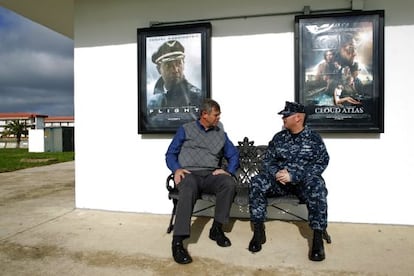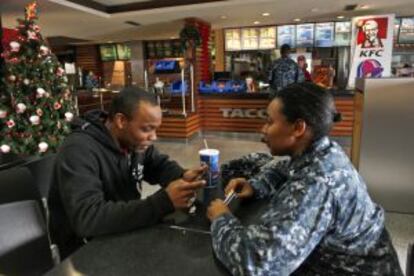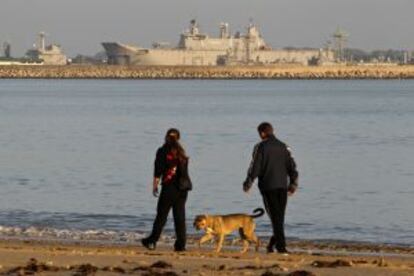Rota: a bit of America in Spain
This year the US naval base celebrates its sixtieth anniversary The permanent stationing of four US warships as part of an anti-missile shield is slated for 2014

With its wide, bungalow-lined avenues, fast-food outlets, drive-in movies, baseball diamonds, and golf course, Rota naval base feels pretty much like small town America. Covering 2,300 hectares, and ringed by a 26-kilometer fence, it is home to 20,500 people: almost 9,000 Spanish navy personnel, 2,000 US military personnel and their families - 3,000 Spaniards and 2,000 Americans - along with 1,500 employees. It has its own port and airport, and over the sixty years since it was set up, it has played a vital role in the social and economic life of its host town of the same name, close to the historic Atlantic port of C¨¢diz.
Rota naval base is about to take on a new lease of life: in October 2011 then Socialist Party Prime Minister Jos¨¦ Luis Rodr¨ªguez Zapatero made the surprise announcement that NATO had selected the Spanish naval base as its main operating center for the sea-based component of the alliance's anti-missile shield.
Zapatero made the announcement during a visit to NATO headquarters alongside US Defense Secretary Leon Panetta and NATO chief Anders Fogh Rasmussen.
"Spain is a [NATO] member committed to the collective defence of Europe," Zapatero told a news conference, adding that the deal will "also guarantee the defense of our territory and the Spanish people."
The base has played a vital role in the social and economic life of Rota
A year later, on October 10, 2012, Defense Minister Pedro Moren¨¦s signed the deal.
Under the terms of an agreement negotiated in secret, the United States will deploy 1,100 military personnel and 100 civilians to Rota to operate the defense system.
Although the United States has not given details of the type of ships to be based at Rota, they are expected to be equipped with the latest version of Aegis, which was specially designed to provide protection against ballistic missiles. The US Navy has 18 ships with Aegis on board: 15 Arleigh Burke class destroyers and three Ticonderoga class cruisers. Both 6,500-ton classes have crews of 350.
The four vessels assigned to missile shield duties will be the first US Navy ships to have their permanent base in Spain. US ships that currently make port call visits to Rota are based in Italy. Although the Spanish Navy has four F-100 frigates also equipped with the Aegis system, it is not foreseen for the moment that they will also be deployed as part of the NATO initiative.
Home to 20,500 people, it has an air reminiscent of small-town America
When Zapatero made the announcement in October 2011, he said the deal would create 300 direct jobs, and a further 1,000 indirectly. It has since been announced that the 8.4 million euros-a-year maintenance contract for the four US warships will be put up for tender.
"There are a great many factors to take into account when assessing the economic impact of the defense system," says Captain Scott C. Kraverath, the commanding officer at Rota, "but the increase in personnel and the need for properties off the base will obviously have a positive effect on the local economy."
Eva Corrales, the Popular Party mayor of Rota, is less diplomatic: "This was sold to us as a cure-all, but it's not going to be quite that. Nevertheless, Rota is the biggest employer in the area."
The town of Rota has 29,125 inhabitants, 14,000 second homes, and 4,455 jobless, around a third of the workforce. Jos¨¦ Mar¨ªa Caravaca, a Spanish navy captain who has been stationed here for 26 years, estimates that the base generates around 400 million euros a year in terms of salaries and its links to some 700 businesses.

But there will be no return to the days of the early 1980s when there were 16,000 Americans based at Rota, when nuclear submarines docked here and the town's population more than doubled in a decade - with many Americans marrying locally.
"Thirty years ago, US personal earning, say, $1,000 a month had the spending power of what most Spaniards earned in three or four months," says Antonio Franco, a local councilor for the United Left.
Ana Mar¨ªa Exp¨®sito, the vice president of the local chamber of commerce, says that many local people came to depend on Rota. "My father was a waiter: he gave up his job in the village and went to work on the base, where he earned a third more. He now has a great pension. The base paid for my education, and that of my brothers. You won't find many people here with anything to say against the base."
A regional grouping of environmentalists, labor unions and other organizations opposed to the continued presence of the US military on Spanish soil, says that it attracts little support locally. It stages a march each year past the base, in which the United Left takes part, albeit with its own banner, saying: "Less servicing the military and more jobs." Manuel Carmona of the United Left says economic reality is hard to fight: "Round here saying no to the bases, to NATO, means 1,000 households with no income. This place drives the economy. What we want is proper compensation for the US presence. If they paid proper compensation for being here we could start to develop other sources of income, create new jobs. Because if the Americans decide to move the base to Gibraltar, then we would be left with nothing. But nobody wants to be seen to bite the hand that feeds them."
You won't find many people here with anything to say against the base
Manuel Jes¨²s Helices, a local United Left councilor, explains that most people's goal in the town is to buy an apartment or house and rent it to the Americans on the base. "The base has killed our entrepreneurial spirit. We have grown dependent on them, and what's more, nobody will talk about it: it's taboo."
Mayor Corrales describes the base as a "tax haven," pointing out that the Americans do not pay any local taxes. She is currently embroiled in negotiations with Madrid, and wants the central government to pay compensation: "We cannot have a town within a town where one pays taxes and the other doesn't."
Last week she was finally given approval to charge registration tax on vehicles brought onto the base from the United States. She hopes that the central government will overturn a ruling by the Supreme Court that the local council cannot charge property tax on non-military buildings on the base such as housing or restaurants, which Corrales says would bring in some 1.3 million euros a year. The battle to impose taxes on the base dates back to the 1980s. In 2002, the Supreme Court backed the town council saying that it could tax non-military activities.
But no government since then has been prepared to act on the ruling and instead a change was introduced to the tax law extending the tax exemption to military establishments. In response, Rota town hall decided to stop paying the central government the equivalent of what it calculated it was losing in revenue from the non-tax-paying base. The Supreme Court's most recent sentence, in 2007, rules that Rota town council must pay the state almost 1.2 million euros.

The court's decision was based on changes to the tax law. "The base makes up 60 percent of Rota's economy," says the mayor, but "it generates tremendous dependency."
Nothing can be built under the air corridor over the base, and nothing can go through the base. But locals insist that the base has been largely beneficial to the community. "When this was built there was nothing here. This land was used for growing tomatoes and pumpkins," says a senior Spanish officer. "In fact, when building started, they used donkeys to bring the stone."
Rota also marked a turning point in the history of Franco's Spain, signaling the end of the country's isolation by the Allies for having initially supported Germany in the Second World War - despite its supposed neutrality - which saw it excluded from the Marshall Plan.
The United States government took steps to normalize its political and economic relations with Spain between 1948 and 1950. In September 1950, President Truman signed a bill that appropriated $62.5 million for aid to Spain. In the same year, the United States supported a UN resolution lifting the boycott on Franco's regime and resumed full diplomatic relations with Spain in 1951. Spain became an increasingly important link in the overall defense system of the United States against the Soviet Union.
We've grown dependent on them, and nobody will talk about it: it's taboo"
In 1953 Franco signed the Pact of Madrid, further symbolizing the Spanish regime's rehabilitation. It also marked the end of Spanish neutrality. The pact consisted of three separate, but interdependent, agreements between Spain and the United States. It provided for mutual defense, for military aid to Spain, and for the construction of bases there. The United States was to use these bases for a renewable ten-year period, but the bases remained under Spanish sovereignty. Although the pact did not constitute a full-fledged military alliance, it did commit the United States to support Spain's defense efforts. Furthermore, it provided Spain with much-needed economic assistance. During the first ten years of the pact, the United States sent approximately $1.5 billion in all kinds of aid to Spain.
"We now have to swallow a bitter pill: a military accord with Franco's Spain. Let's hope the medicine does more good than harm," wrote the New York Times in an editorial in 1953. Two years later, in 1955, the UN approved Spain's membership. In a visit by then US President Dwight D. Eisenhower to the Spanish capital in 1959, the two generals received warm public welcomes as they toured the city together. The visit further emphasized Franco's acceptance and the end of Spain's ostracism. Franco placed a high value on Spain's relationship with the United States for the prestige it conferred as well as for strategic reasons. This relationship continued to be a dominant factor in the development of the country's foreign policy.
Spain is negotiating the inclusion and participation of its navy F-100 frigates in the US anti-ballistic missile defense system. Defense analysts say Spain will play a key role in the naval component of the defense shield, repositioning its foreign policy squarely within NATO and as a solid and reliable US ally.
Spanish military sources say frigates equipped with SPY-1 D radar and the same Aegis combat equipment that the US navy has to track ballistic missiles will only require a change of software to enable their integration into the anti-missile shield.
What is unclear still is who will pay for the SM-3 interceptor missiles for the Spanish frigates, although this could be provided by the US as part of a broader military initiative for the pooling of NATO resources by the 28 allied member states known as Smart Defense, which aims to share costs and minimize the impact of defense budget cuts in the current economic crisis.
Vessels equipped with the Aegis system can also operate land based Patriot missiles deployed by other allies.
Spain and Norway are the only NATO members with this capability, although Norwegian frigates built by Spain have a somewhat inferior capacity.
NATO hopes Spain's strong commitment will influence other countries to participate in one way or another in the US-led program. The war in Libya showed NATO that to reach desired efficiency levels in the face of new geo-strategic threats, European countries are obliged to share their capacities.
According to a leaked Spanish Defense Ministry report last year, "The Spanish Navy is in an advantageous position to achieve with moderate investment in the short term, a capacity equivalent to that of last generation US navy vessels and therefore capable of a quantum leap in its contribution to NATO's collective defense effort."
Iran's long range nuclear weapon program is seen as the greatest threat affecting much of continental Europe. In political terms Russia's opposition to the US-Europe anti-missile defense shield deployment on the basis that it can deactivate its own nuclear arsenal - while the US keeps its own nuclear capability intact - is another factor which could resurface and lead to a serious confrontation with NATO, following Vladimir Putin's return to the nation's presidency.
Spanish naval officer Jos¨¦ Mar¨ªa Caravaca dismisses fears that the increased military presence will make Rota a potential terrorist target. "The alert level of the base, far from increasing, has been lowered in recent years. Being part of a defense system like this increases our collective security. There was no way we could say no to it."
The naval base is now firmly a part of life in Rota, even if it's not what it used to be: for some local people it was their first exposure to rock music; it was the place to acquire condoms; American cigarettes; or jeans. "The base brought modernity," says Caravaca: "When we came here it was the first time that we saw female members of the military."
He tells the story of when Manuel Fraga, Franco's former tourism minister and later head of the regional government of Galicia, visited the base in 1986 during the US bombing of Libya amid suspicions that the Spanish had provided support. Fraga reportedly commented afterwards: "There is nothing going on here: the only thing I have seen are a few Americans playing golf and three lovely looking black girls."
Tu suscripci¨®n se est¨¢ usando en otro dispositivo
?Quieres a?adir otro usuario a tu suscripci¨®n?
Si contin¨²as leyendo en este dispositivo, no se podr¨¢ leer en el otro.
FlechaTu suscripci¨®n se est¨¢ usando en otro dispositivo y solo puedes acceder a EL PA?S desde un dispositivo a la vez.
Si quieres compartir tu cuenta, cambia tu suscripci¨®n a la modalidad Premium, as¨ª podr¨¢s a?adir otro usuario. Cada uno acceder¨¢ con su propia cuenta de email, lo que os permitir¨¢ personalizar vuestra experiencia en EL PA?S.
En el caso de no saber qui¨¦n est¨¢ usando tu cuenta, te recomendamos cambiar tu contrase?a aqu¨ª.
Si decides continuar compartiendo tu cuenta, este mensaje se mostrar¨¢ en tu dispositivo y en el de la otra persona que est¨¢ usando tu cuenta de forma indefinida, afectando a tu experiencia de lectura. Puedes consultar aqu¨ª los t¨¦rminos y condiciones de la suscripci¨®n digital.









































